Green/black linen suit, with Davide Taub at Gieves & Hawkes
Relief, and relaxation. Those are my abiding memories of this, my fitting at Gieves on a new suit.
Readers commented on a previous post that it was nice to know what I was thinking and feeling during a fitting. That it felt more immediate and personal.
Here I immediately felt relaxed with Davide (Taub, below, head cutter). This is primarily because Davide has made three things for me over the years, beginning in 2013: a leather jacket, a pea coat, and a gilet.
As a result, I was at ease - there was a relationship. Indeed, the kind of relationship most people don’t have these days. Not just between a craftsman and a client, but something more personal, necessitated by discussions over your lifestyle, tastes and wardrobe over a period of time.
The primary advantage of this is that I find it easier to tell Davide what I want, and when I don’t like something.
It seems ridiculous, but even though I’ve done this scores of times, I’ve never found it easy to tell a tailor what I think.
I used to think it was me; then that it was being English; now I realise everyone feels like this. It’s just not easy to create potential awkwardness.
The second, related feeling was one of relief. Because the suit fit well from the start. Davide is a professional, he has done this every day for years, and he knows how to do it.
This isn’t always the case. There are so many start-up tailors today that they often don’t have much experience. There are fairly large issues to steer around early on.
It’s not as simple as saying that Neapolitan tailors, for example, are not as good. It’s more that there is more variation in other places: the cheaper tailors that largely died out in London in the 1980s and 1990s still exist in Naples, and in other smaller cities. They haven’t been replaced by ready-to-wear to the same extent.
Also, because bespoke tailoring is so expensive, men are always searching for something cheaper. And the thing they often sacrifice without realising it, is experience. A cutter that’s been at the top of his game for 20 years just costs more.
But I digress. Having felt that initial sense of relief, I let Davide and Oliver (Spencer, above) busy themselves checking, chalking and noting.
Long-term readers might recognise Oliver from Anderson & Sheppard, back when I used to run their in-house blog The Notebook.
He is now at Gieves, and building on the trouser apprenticeship he did at A&S to add every other aspect of tailoring.
I had few comments on the fit, other than that the back felt a little tight and the trousers a little narrow (although on sitting down in them, they were actually perfectly comfortable).
Most comments were about style. I find it consistently interesting, for example, where the waist button is placed.
Most men today would rarely say that this buttoning point is too low, but quickly point out when it seems too high. This is of course very much subject to fashion, and we are more influenced by what we see around us than we like to admit.
As with most things, the interesting thing is to not to throw out judgments about such subjective, aesthetic choices, but rather to enquire what lies behind them.
So with the buttoning point, many men feel that lower is better because it lengthens the opening in the jacket, creating a flattering ‘V’ down the chest.
It certainly does this, but always a little at the expense of the skirt (the jacket below the waist). This can be very stylish, angling outwards over the hips and adding sharpness as well as flare.
This is often particularly obvious in WW2-era officers’ jackets, with their belt around the natural waist and big skirt, emphasised by bellows pockets.
That is, of course, not what Davide was aiming for here. But the aesthetics of that cut play a lot into the style of English structured tailors such as Gieves, Dege, Huntsman and the like.
Although having said that, it might not be accurate to call Gieves ‘structured’ any more.
The actual interlinings that Gieves uses has been getting gradually lighter in recent years, even before Davide joined. Today he uses three weights of body canvas and two of horsehair, and varies them depending on the cloth and the customer.
Some even leave out the horsehair entirely, such as the sailing jacket below, which is made to be much more casual, in a jersey cloth.
Most of the time the structure is the same (body canvas, horsehair, domette) and only the weight varies.
With mine, this was the case, and it was impressive how different it felt. Almost as light as the Neapolitans, and certainly more than the Dege & Skinner linen I had two years ago (though that was also a heavier linen).
Davide says that both younger and older customers have reacted well to this: younger ones because it’s more similar to the Italian ready-to-wear they have, and older ones because it makes them realise a Savile Row suit doesn’t have to mean just one construction.
The way he puts it, there are customers that have a strongly built Row suit, understand its value and strength, and are proud of it. But they don’t necessarily order their whole wardrobe like that - they want lighter things too.
This variation in canvas allows Davide and the team to do that.
All of which musing on tailoring technique is to ignore the first question readers will have asked, which is: what’s the cloth?
It’s a 250g Scabal linen, number 802258, and I can only describe the colour as charcoal-green.
It looks dark, like a dusty black, under artificial lights, but quickly shows its green cast when outside.
I was after something smarter to wear with black shoes, but still lightweight and summery, and wasn’t sure that could be done in linen. In general, linen looks better in stronger or warmer colours. I’ve never liked it in navy, for example, where it usually just looks like a tired worsted.
More on the cloth, the suit’s style and everything else in the next post, which will likely be part of the Style Breakdown series.
Photography: James Holborow


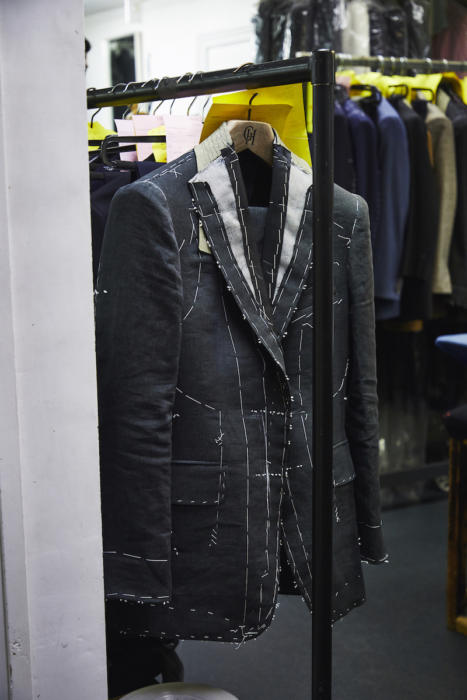
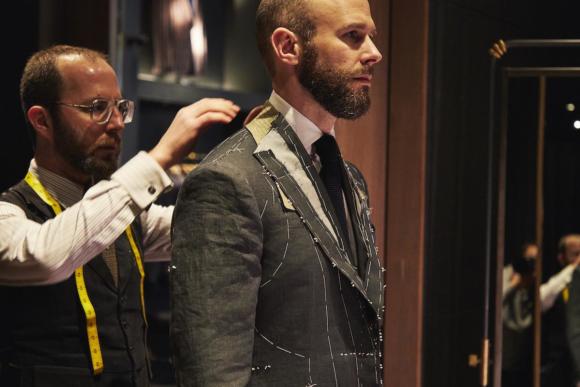
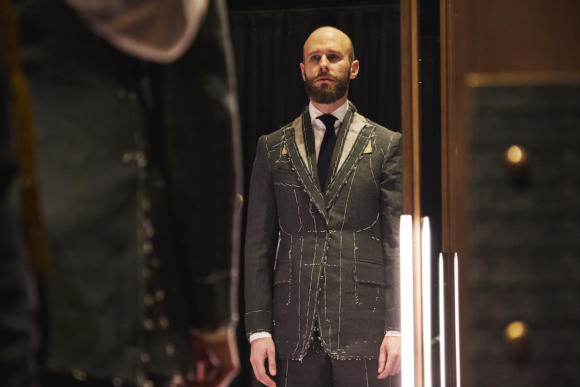
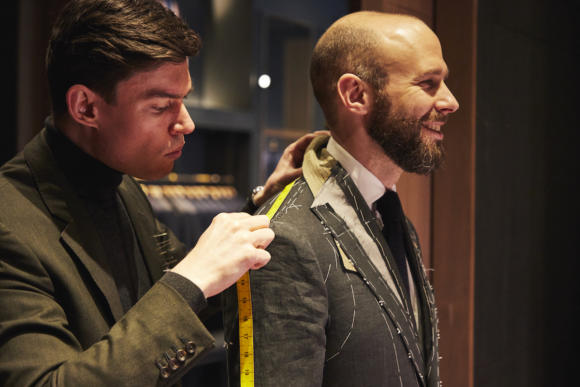
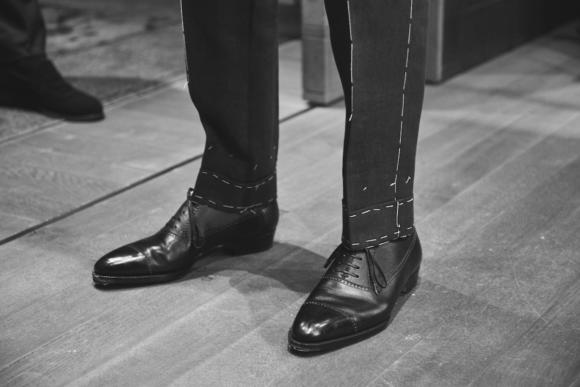
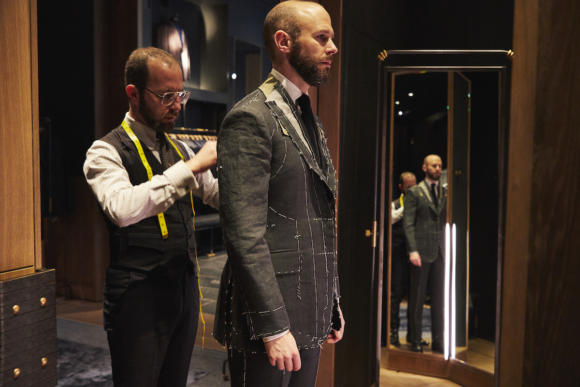
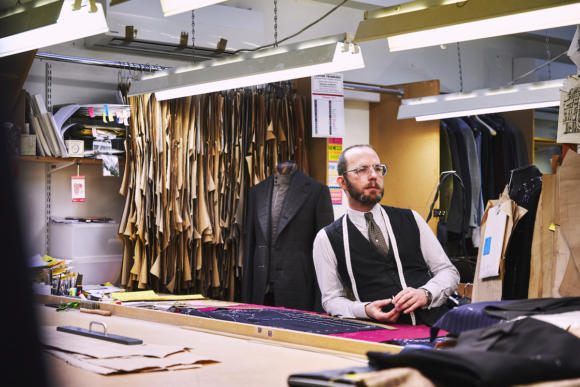
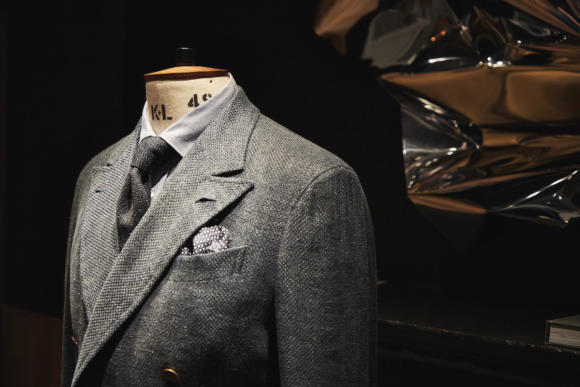
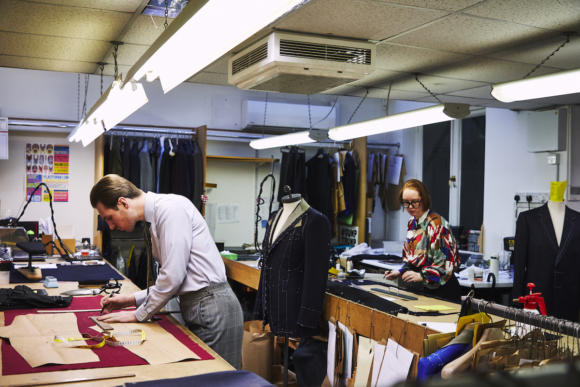
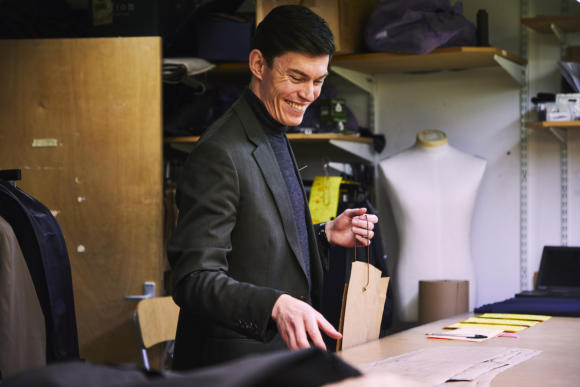
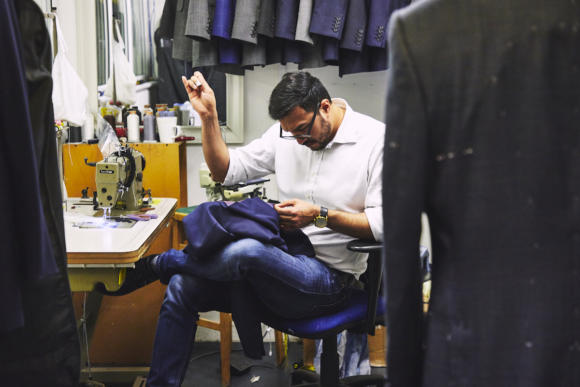
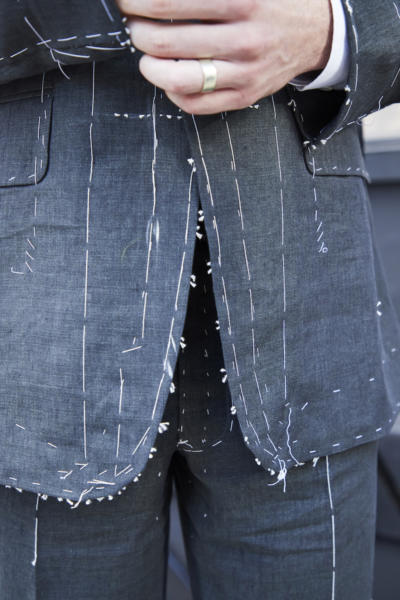


























My first question was actually why have you chosen Gieves & Hawkes for this suit? Why is their style and cut the one you want this time?
I wanted to work with Davide, primarily, having never made a suit with him but talked to him about his tailoring for a long time
Simon, you are preaching that you would choose Naples for casual clothes and Savile Row for more formal garments and nevertheless you often end up ordering linen suits at the Savile Row. 😀
The Dege and Skinner tobacco linen in the past, and now this one…
Hey Hristo. Yes true, but I wouldn’t necessarily think of a linen suit as casual clothes. Given I’d most likely wear either with a tie.
I take it the cloth creases very easily?
Yes, very
Gone against your own advice 😉
Do you take into account the creasing and alter the measurements accordingly? I am thinking about the leg length for example…
Yes, in particular the leg length, though the sleeves a little as well. Sitting down and chatting for ten minutes is usually enough to get those creases in, and then look at the lengths
I do not get why a low buttoning point implies a flared skirt. Is it a consequence or for aesthetic harmony? Can you elaborate? I do understand it impies quarters sometimes opening with a wider angle.
Hi Gonzague. A lower buttoning point doesn’t necessarily mean either. The point is that if the button is lower, the skirt is shorter, and it therefore has less impact aesthetically
Looking forward to seeing this suit in the style breakdown comments.
Walking past Gieves always puts me off. They have some of the most gopping displays…. Including one with a blue tail coat and short trousers that must be an Ascot / Summer piece….
And going in there I always think is devoid of charm. Simon, does the bespoke side have a bit more taste and style to it than the RTW and MTM?
The bespoke is pretty much entirely separate, and driven by Davide’s cut and style
Nearly an answer to my question, ha! Very PC.
True, the facade of the house on SR nr. 1 and the shop itself is frightening. It took me several years to find i.e. push through to the bespoke department. But the team with Davide is definitely worth the journey for those interested in bespoke from a-z, that is for a honest approach to tailoring, long time consistency and trust.
Each time I went into G&H, it was very cold and not welcoming with no one on the RTW even saying hi etc. I did see what appeared to be the entryway to the bespoke side but it almost looked to be guarded. Do potential bespoke clients need appointments just to go in and chat about their cut etc. Or can you just walk in and ask questions?
You can just go in and ask questions – that section at the back is for bespoke and MTM, and there’s a desk on the right where you can normally ask to see someone for questions etc
Your feeling about G&H interior decoration might be expressed to somebody who needs to know it and has the power to change it: managing director Nick Kyte. When I complained the colour name cobalt on the website didn’t quite match blue of the RTW trousers I bought, Nick was very polite and very helpful.
Well made observation about buttoning point and skirt: I think for many the latter is less important due to modern, slimmer silhouettes. I also wonder about the cutting of the skirts. Older cuts (70’s and beyond) had a greater flair and shape, it’s possible to recreate but mainstream RTW, which tends to lead the fashion on silhouettes, has forgotten how to achieve this, possibly due to the higher construction cost (as it requires greater shaping than a flatter, shorter skirt).
Interesting how you mention the minutia of getting button positions right . In that vain may I recount my own experience .
I , as I suspect many others do , started my sartorial journey having sleeves altered on RTW suits
Whilst doing this I’ve noticed that Tailors reference the sleeve alteration against the shirt cuff/ sleeve you have on at the time .
Having now taken a step into tailored shirts it’s now apparent those ‘altered’ jackets don’t show the cuff .
(Bear in mind we’re talking alterations of 1/8 to 1/16 of an inch making a big difference to the desired effect).
It raises the bigger question of should Tailors reference / measure against clothes you have on or your body ? (i.e. measure from top of thumb to agreed sleeve point).
In my experience , regarding alterations , it seems to have been against clothes .
If your shirts are pretty much all the same in terms of sleeve length, its best to go off them rather than your hand. A tailor will often want to go off the hand, because he doesn’t want to be dependent on shirts he wasn’t involved with. But that only really makes sense if you don’t already have lots off shirts you like
I really like the idea of the colour as you describe. I know black is always a controversial colour choice for suits but I’ve a RTW black linen from Purple Label that I love. In spite of this it is hard to get the accompanying pieces to work well if you are trying to be smart in it – Tarantino-esque interpretations aside. It works better for a more casual look. This feels like it would be more versatile. I guess we live and learn.
Best wishes N
Ciao Simon. I am partly agree with you about experience and price in bespoke world. But Naples is unique in this way – there are so many tAilors that you can find amazing small Sarto with Huge experience (I mean 40-50 years) but with very reasonable price (1,5-2 k Euro for real bespoke)
I don’t think it is true that everybody has trouble telling the tailor what they think because the first time I met two Huntsman representatives in Zürich they complained to me about a customer they awaited who did just that. I think your problem to express yourself to tailors has to do with the attitude of the tailors you meet, Simon, who do not encourage or do not know how to encourage you to say what you think. Your inhibition may be also dependent on English mentality.
Thanks Peter. It may well be because of my culture, but I doubt it’s because of the tailors I use, given how many I have done so with
“It certainly does this, but always a little at the expense of the skirt (the jacket below the waist). This can be very stylish, angling outwards over the hips and adding sharpness as well as flare.”
“This” is a vague pronoun here: what, precisely, is “very stylish?” Certainly no reasonable buttoning point is so low as to do away with the skirt altogether, so I assume you mean that there should be sufficient skirt to achieve a flaring effect. Though I agree the effect is important, I think it’s more dependent on the openness of the quarters. (I’ve always disliked very closed quarters partly because of the stuffy, boxy silhouette they create. I could go for a bit more openness on the commission in this post, in fact.) I’d be interested to see a jacket that illustrates the problem as you see it.
The primary problem with too low a buttoning point for me is simply its effect on the balance of the outfit. While I favor a more prominent chest, at some point one becomes top-heavy and cartoonish.
Thanks. By ‘very stylish’ I merely mean that the skirt is something that can add style to a jacket, but often men don’t think about it or de-prioritise it.
Good point on the quarters, they do have a larger effect.
“It certainly does this, but always a little at the expense of the skirt (the jacket below the waist). This can be very stylish, angling outwards over the hips and adding sharpness as well as flare.”
“This” is a vague pronoun here: what, precisely, is “very stylish?” Certainly no reasonable buttoning point is so low as to do away with the skirt altogether, so I assume you mean the three should be sufficient skirt to achieve a flaring effect. Though I agree the effect is important, I think it’s more dependent on the openness of the quarters. (I’ve always disliked very closed quarters partly because of the stuffy, boxy silhouette they create. I could go for a bit more openness on the commission in this post, in fact.) I’d be interested to see a jacket hat illustrates the problem as you see it.
The primary problem with too low a buttoning point for me is simply its effect on the balance of the outfit. While i favor a more prominent chest, at some point one becomes top-heavy and cartoonish.
Random question Simon, but we never see you in a three piece? Any reason why?
I don’t wear waistcoats really. (Although I used to be a fan of wearing a waistcoat and trousers on their own.) It’s largely because for a waistcoat to fit well and really function as it’s meant to with no shirt showing beneath it, the trousers have to be high waisted and probably with braces, which are styles I don’t really like. I have had waistcoats in the past, eg from Chittleborough, but find I rarely wear them
Black really only works for black tie.
Best avoided in any other context unless you’re in a Tarantino movie.
Glad that’s sorted then…
Nice to have the definitive position.
I am with Anonymous as regards black, but would add funeral director, where black seems entirely appropriate.
Starting to look like a really smart suit for the warmer months! I’m wondering though, wouldn’t the benefits of linen be mitigated by the fact that this will be quite hot in the sun?
Because the colour won’t reflect the sunlight as a lighter colour would, you mean?
Brave, though intelligent, choice of cloth. I understand your thinking and look forward to the result. Good also to see Oliver, very nice guy, he has a suit, cut by John Hitchcock, which is one of the best I’ve seen (at A&S). I’d like to second some of the comments re. the RTW section of Gieves – it’s very impersonal and off-putting. It’s an area that Gieves could do well to concentrate on (better displays, better lighting, a decent welcome, warmer, improved service disposition). Gieves in Birmingham achieved this some time ago – so it can be done.
Simon,
What is the cost of a suit like this one from Gieves?
Thanks,
Michael
Sorry, I thought I put that in. It’s among the more expensive on the Row: £5300 including VAT
Simon, what brand & model are those shoes? I like them
Mori, a new made-in-China company being started by Maslow So. More details on Instagram under ‘MoriOfShoemakers’
Hi Simon – that really is a fantastic color green. Seems quite versatile. How would you choose between a very dark green or a very dark brown for a summer suit? In terms of usefulness, formality, odds of seeing someone else in the same color, etc? Thank you.
It depends on the precise shade, but if I liked both equally I would always go with green, because it’s easier to wear with brown shoes
It’s interesting you should say that since I thought this particular green black linen would pair well with a black shoe. Are you wearing a black tie in the fitting pictures too, or is that navy?
What’s been your experience with your dark brown crispaire suit? Do you wear it often, or do you find it hard to use? Thank you.
Yes, I’m wearing it with a black tie in the fitting pictures.
The dark brown is good, and it does go with a decent range of shirts and ties. But a green in the same tone would be more versatile. Easier to wear with brown shoes.
Hi Simon, You have touched almost all aspects of every nook and corner. Can you put some light on tie with tuxedo as well.
Wearing a long tie with a tuxedo? Just don’t, I’m afraid. It looks cheap and inappropriate. If you want to wear a long tie, wear a sharp suit instead of a tux. If you want to vary black tie, get velvet, a double breasted, or small variations in the shape and texture of the bow tie or shirt
I’ve been looking at the very same fabric for a work suit as I live in Northern California where the heat gets well above 100 degrees F. Tried to link to the Style Breakdown but didn’t see pics of the finished suit. Will we be able to view the finished product? I’m interested to see how it looks especially with your description of the color of black/charcoal/green; I’ve searched far and wide for a summer fabric in Hunter/forest green and prefer a fresco but am considering this Scabal Pure Linen as an alternative.
Yes, there will be a post on the finished suit, just haven’t done so yet
Lovely suit and article Simon, thank you for sharing it.
I am considering an 8oz Navy Scabal Made to Measure single breasted 2 piece suit by Mason and Sons for weddings in Spain and Italy next summer. One invitation is as a best man (dress code is navy trousers with or without a jacket and a white shirt), the other invitation as a guest. Would you recommend linen firstly over something like an 8oz super 110s or 6oz super 150s in worsted wool, and Scabal secondly over the same weight or heavier Irish or Italian linen for these occasions?
Many thanks in advance and best wishes
Hi Andrew,
On linen v wool, I think linen would look more interesting and a wedding, and unlike anything for business; but wool would also be easier to wear for business afterwards. So that’s the choice for you I think.
On linen weight, I do always prefer a heavier Irish one, but if it’s summer weddings in Spain and Italy then yes a lightweight 8oz one will be more comfortable.
S
Simon I like clothes and associated good taste, however I find your column Very hard going. Exhausting actually.
Sorry to hear that Norman. Any more concrete feedback always appreciated
Good
Hi Simon – are you still getting much use from this suit 3 years later? How do you think the green/ black color would work as an odd trouser? Thank you
I do wear it, but I wouldn’t say it’s a versatile, wear-every-week piece. More occasional (in both senses). I don’t think the trousers would be great in that respect either. I’d just go for a normal dark-green linen
Hi Simon – I bought a linen DB suit from Rubinacci in olive last year. It’s a heavier linen though I’m not sure of the exact weight and I’m tempted to wear it now in the winter season. What are your thoughts on wearing linen in the winter?
Hey Christian,
I think a linen full suit can look a little out of place perhaps when it’s actually cold out. On a milder autumn or spring day it’s easier and might look more appropriate. Also, the jacket on its own would be easier to wear rather than the suit as a whole. Have you tried that?
Thank you for your thoughts on this, Simon and I agree. Now on to find a nice trouser to pair it with as an alternative.